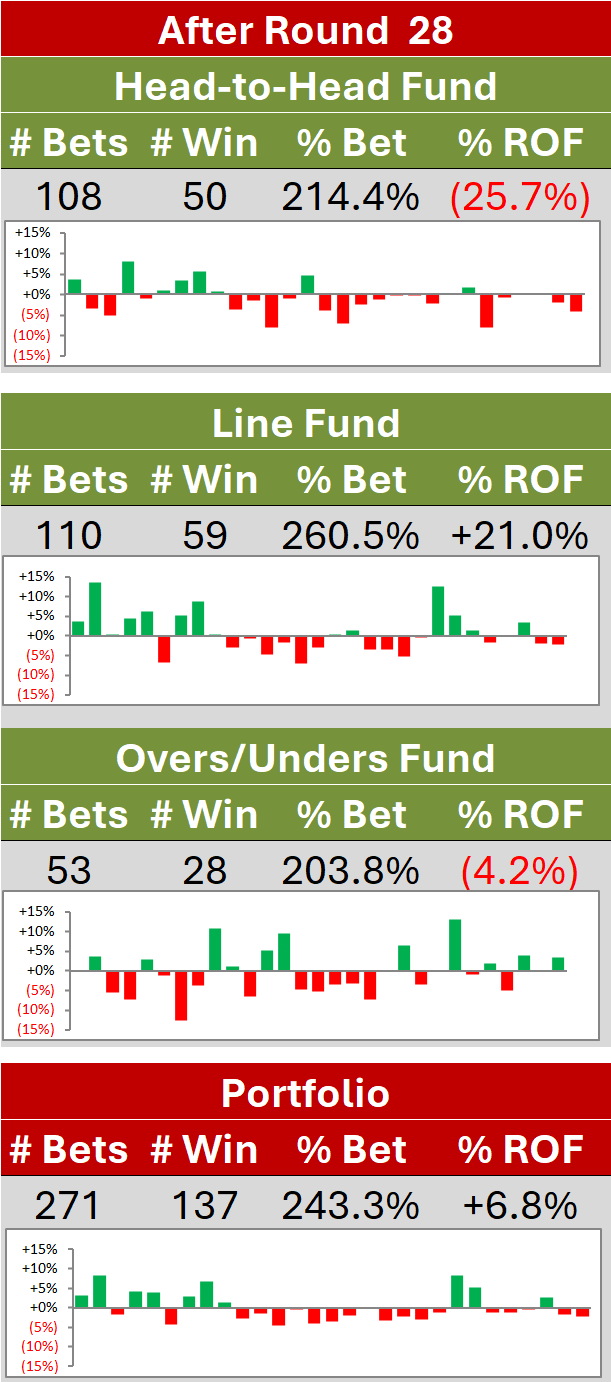Do You Have Closing Line Value?
/The adequacy of any decision should never be assessed purely on its outcome, but instead on how well it reflected the information available at the time. In wagering, that means profitability is often a poor reflection of the ability of the wagerer, although it becomes a fairer measure the longer the time span of wagers we are reviewing.
There’s another, perhaps better, metric that we can use, which provides an expert’s pre-game assessment of how well a wagerer has used available information, and that is the frequency with which the wagerer creates what is called Closing Line Value (CLV). Put simply, a bet has positive CLV if, at the line or price at which the market closes, the bet has a positive expected return assuming that the bookmaker’s final line or price provides an accurate estimate of the team’s true outcome probabilities.
A positive CLV is good, and the more positive it is, the better.
AN EXAMPLE
Purely to illustrate the point, imagine a bookmaker whose head-to-head prices in a contest where draws are not possible include zero vigorish (ie are ‘fair’ prices). For such a bookmaker, their true estimate of the probability of an outcome is the inverse of the price they’re offering. So, if they believe Team A has a 40% chance of victory, they’ll offer a fair price of 1/0.4 or $2.50.
Now imagine that you have secured a wager on Team A at $2.25 and that, when you look just before the game starts, the bookmaker is now offering only $2.10 for Team A.
That means his or her true estimate of Team A’s victory probability has changed to 1/2.1, which is 47.6%. If that probability is accurate, the expected value of your wager per unit is $2.25 x 47.6% -1, which is +7.1%. That wager then has a healthy positive CLV.
GETTING REAL
In reality, bookmaker prices incorporate vigorish or vig, which we need to remove if we are to determine a bookmaker’s implicit probability estimates. For this blog we’ll assume a flat 5% vig is built into the price of all favourites and underdogs, so that a fair price can be ascertained by multiplying the offered price by 1.05.
(Technically, I’m actually assuming a 5% overround here, which is equivalent to a 4.8% vig.)
So, working through the previous example where we had secured a wager on Team A at $2.25 only to find that it had moved to $2.10 by game time, our new estimate of the bookmaker’s true victory probability estimate for Team A is 1/(2.1 x 1,05), which is 45.4% making our new estimate of expected value $2.25 x 0.454 - 1, which is only +2%.
The reason for the change in estimated value stems from the fact that our new estimate of the bookmaker’s victory probability for Team A is over 2% points lower.
Note that, had the price fallen to only $2.20, the CLV calculation would have been $2.25 x 1/(2.2 x 1.05) -1 = -2.6%.
That illustrates an important point: positive CLV is not assured if the price falls for the wagered on team. It needs to fall sufficiently to overcome the effect of the vig. The larger that vig, the more the price will need to fall to deliver positive CLV.
CALCULATING MINIMUM REQUIRED HEAD-TO-HEAD PRICE MOVEMENTS
By repeating the calculation just described for different initial head-to-head prices, we can create the table at right, which shows the minimum price movement required to deliver, firstly, a positive CLV and, secondly, a CLV of at least 2% points.
So, for example, if you have secured a head-to-head price of $1.25 in a market with a vig of 5% assumed to be equally levied on the favourite and the underdog, then you need to closing price to fall to at least $1.19 in order for you to have positive CLV, and to at $1.17 or lower for a CLV of 2% or more.
The formulae are as follows:
For a positive CLV: Price Secured - Price Secured / (1 + Vig)
For a CLV of 2%: Price Secured - Price Secured / ((1 + Vig)/1.02)
As you can see, the larger the price secured, the larger the absolute decline in price needs to be in order to secure a positive CLV.
Note that the requirements for a positive CLV according to row one of this table are unlikely to be met, and for a +2% CLV impossible to be met. With a 5% vig and a secured price of $1.05, only a closing price of $1 will imply a positive CLV, a price that no bookmaker would offer, and only a closing price below $1 will imply a +2% CLV.
In reality, empirical evidence is that favourites tend to carry less vig than longshots, so there may, in fact, be room for +CLV price movements on very short-priced favourites, but we’ll leave that analysis for another day.
LINE BETTING
So far, we’ve constrained the analysis to consider only head to head wagering, but it is very simple to extend it to line wagering.
For this purpose, if we assume that vig is levied equally on the two outcomes (ie the probability of the favourite covering the spread is exactly 50%), we need not concern ourselves with the size of that vig, but instead need only make assumptions about the underlying statistical distribution of victory margins around their expected values.
There are a number of blog posts on this site that suggest that, empirically, victory margins tend to be distributed as a Normal about their expected value, or very nearly so, a very early example of which is this post.
Given that, the only remaining assumption we need is the standard deviation of that distribution. Now there is some evidence that the standard deviation might increase with the expected total score of a game but, for simplicity, I’m going to assume that it takes on only a single value for this analysis.
For AFLW, a reasonable value for that standard deviation is 28 points, which yields the CLV analysis tabulated at left.
The underlying formulae here are:
For a positive CLV: NORMDIST(Change in Line, 0, 28, TRUE) x Price Secured - 1 > 0
For a CLV of 2%: NORMDIST(Change in Line, 0, 28, TRUE) x Price Secured - 1 = 2%
So, for example, a line secured at $1.87 will have a positive CLV if that line moves by 3 or more points in the right direction (ie more start for the favourite if we’ve bet on the underdogs, and less start for the favourite if we’ve bet on them), and a CLV of 2% or more if it moves by 4 points or more.
It’s testimony to the ability of bookmakers that, depending on the price they offer, an error of as little as 2 points is potentially exploitable in AFLW.
To finish, we’ll do the same calculation for men’s AFL, assuming a standard deviation of 33 points for their games.
Here you’ll see that the bookmaker has a little more room for error in a few scenarios, but only of about a single point more.
Here, for example, a 4 point or more move in the line in the right direction makes an earlier wager secured at $1.85 a positive CLV wager.

